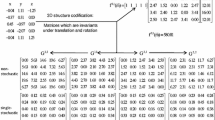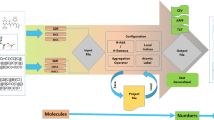Abstract
Recent investigations have shown that the inclusion of hybrid shape/property descriptors together with 2D topological descriptors increases the predictive capability of QSAR and QSPR models. Property-Encoded Surface Translator (PEST) descriptors may be computed using ab initio or semi-empirical electron density surfaces and/or electronic properties, as well as atomic fragment-based TAE/RECON property-encoded surface reconstructions. The RECON and PEST algorithms also include rapid fragment-based wavelet coefficient descriptor (WCD) computation. These descriptors enable a compact encoding of chemical information. We also briefly discuss the use of the RECON/PEST methodology in a virtual high-throughput mode, as well as the use of TAE properties for molecular surface autocorrelation analysis.
Similar content being viewed by others
References
Breneman, C.M. and Rhem, M., J. Comput. Chem., 18 (1997) 182-197.
Embrechts, M.J., Robert Kewley, J. and Breneman, C., Computationally Intelligent Data Mining for the Automated Design and Discovery of Novel Pharmaceuticals. in Smart Engineering Systems: Neural Networks, Fuzzy Logic, Evolutionary Programming, Data Mining and Rough Sets. St. Louis, MO: ASME Press, 1998.
Embrechts, M.J., et al. Scientific Data Mining with Strip-MinerTM. In Proceedings, 2001 SMCia Mountain Workshop on Soft Computing in Industrial Applications. Blacksburg - Virginia: IEEE Press.
Kewley, R., Embrechts, M.J. and Breneman, C.M., Neural Network Analysis for Data Strip Mining Problems, In Intelligent Engineering Systems through Artificial Neural Networks, Dagli, C. Editor. St Louis, MO; ASME Press. 1998. 391-396.
Bennett, K. and Campbell, C., SIGKDD Explorations,2 (2000) 1-13.
Bennett, K., Demiriz, A. and Embrechts, M. Semi-Supervised Clustering Using Genetic Algorithms. In Artificial Neural Networks in Engineering (ANNIE'99). 1999.
Embrechts, M.J., et al. Bagging Neural Network Sensitivity Analysis for Feature Reduction in QSAR Problems. In 2001 INNS - IEEE International Joint Conference on Neural Networks. 2001. Washington D.C: IEEE Press.
Zauhar, R.J. and Welsh, W.J. In American Chemical Society National Meeting. Washington, D.C.: American Chemical Society, 2000.
Wagener, M., Sadowski, J. and Gasteiger, J., J. Am. Chem. Soc., 117 (1995) 7769-7775.
Lockwood, L. In Chemistry. Rensselaer Polytechnic Institute: Troy, 2000.
Aboufadel, E. and Schlicker, S., Discovering Wavelets. 1999, New York: John Wiley & Sons.
Hubbard, B.B., The World According to Wavelets. 1996, Wellesley, MA: A.K. Peters, Inc.
Daubechies, I., Ten Lectures on Wavelets. 1992, Philadelphia: SIAM.
Author information
Authors and Affiliations
Rights and permissions
About this article
Cite this article
Breneman, C.M., Sundling, C.M., Sukumar, N. et al. New developments in PEST shape/property hybrid descriptors. J Comput Aided Mol Des 17, 231–240 (2003). https://doi.org/10.1023/A:1025334310107
Issue Date:
DOI: https://doi.org/10.1023/A:1025334310107




